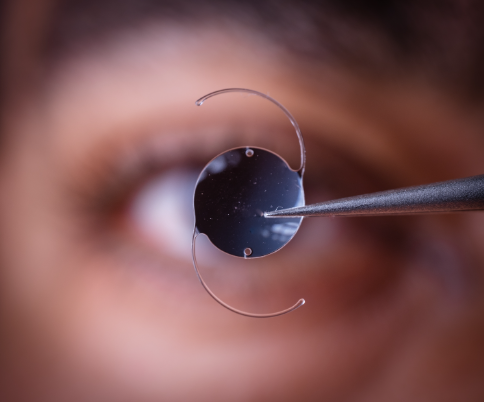28-Feb-25

Imagine waking up one morning, the world around you appearing blurry and dull. You reach for your glasses but realize they no longer serve their purpose. This can be a reality for many dealing with cataracts. Fortunately, advancements in medical technology have made it possible to restore clear vision through IOL surgery. But what exactly is this procedure? How does it work, and what should you know before taking the plunge?
In this blog post, we'll explore everything from the basics of IOL surgery to recovery tips and more—helping you navigate your journey towards clearer sight with confidence. Whether you're searching for the best cataract treatment options or looking for top specialists in Ghaziabad, we’ve got you covered!
What is an IOL and How Does it Work?
An Intraocular Lens (IOL) is a synthetic lens implanted inside the eye to replace the natural lens, often removed during cataract surgery. These lenses are designed to restore clear vision by focusing light onto the retina.
When light enters the eye, it must pass through a transparent lens that bends and focuses it accurately. In cases where cataracts cloud this natural lens, an IOL takes over its function post-surgery.
IOLs come in different designs tailored for various visual needs. Some are monofocal, providing clear vision at one distance—either near or far. Others are multifocal or accommodating lenses, allowing for better focus across multiple distances.
Once implanted, IOLs generally require minimal maintenance and can last a lifetime. They work seamlessly with your eye's anatomy to enhance overall vision quality without significant side effects.
Types of IOL Surgeries
IOL surgery offers various techniques tailored to individual needs.
The most common type is the standard IOL surgery, where a monofocal lens is implanted. This lens corrects vision at one distance, typically for far sight.
Another option is multifocal IOL surgery. Multifocal lenses allow patients to see clearly at multiple distances—near, intermediate, and far—reducing dependence on glasses.
Toric IOLs are designed specifically for those with astigmatism. These lenses can correct uneven curvature in the eye while addressing presbyopia or myopia.
Advanced options also include accommodating IOLs, which move within the eye to provide better focus across different distances.
Robotic cataract surgeries enhance precision through advanced technology. Surgeons use robotics for improved outcomes and faster recovery times.
Each type of surgery has its unique benefits, making it essential for patients to discuss their specific needs with an experienced ophthalmologist before proceeding.
Benefits and Risks of IOL Surgery
IOL surgery offers numerous benefits. One of the most significant advantages is the restoration of clear vision. Many patients experience improved eyesight and a greater sense of independence.
Another benefit is the quick recovery time associated with modern techniques. Advanced methods, such as robotic cataract surgery in Ghaziabad, allow for less discomfort and quicker return to daily activities.
However, like any medical procedure, IOL surgery comes with risks. Potential complications can include infection or inflammation. Some patients might also face temporary visual disturbances post-surgery.
It's essential to discuss these risks thoroughly with your eye care specialist beforehand. Understanding both sides helps ensure informed decision-making about your treatment options at top cataract surgery clinics in Ghaziabad.
Preparing for an IOL Surgery
Preparing for IOL surgery involves a few important steps.
First, your eye specialist will conduct comprehensive tests to assess your vision and overall eye health. This helps in determining the most suitable type of intraocular lens for you.
Next, it’s essential to discuss any medications you are currently taking. Some may need to be paused or adjusted before the procedure. Your doctor will guide you on this.
On the day before surgery, avoid heavy meals and follow any specific fasting instructions provided by your surgeon. Arrange for transportation since post-surgery blurred vision can make driving unsafe.
Consider packing a small bag with essentials like sunglasses and discomfort-relief items. Having these ready can ease your transition back home after the surgery is complete.
Recovery Process and Aftercare
After IOL surgery, it's crucial to follow your doctor's instructions for a smooth recovery. You might experience some blurriness or discomfort initially. This is normal and should gradually improve.
Rest is essential. Allow your eyes time to heal by avoiding strenuous activities for at least a week. Protecting your eyes from dust and bright lights also aids in recovery.
Medications, such as anti-inflammatory eye drops, may be prescribed to reduce swelling and prevent infection. Consistency with these medications enhances healing.
Regular follow-up appointments are important to monitor progress. Your surgeon will guide you on when it’s safe to resume daily activities like driving or exercising.
Most patients notice significant improvement in vision within days of surgery. Listening to your body during this period can lead to the best outcomes long-term.
Frequently Asked Questions
What are the common symptoms that indicate IOL surgery may be needed?
Patients often notice blurred vision, difficulty with night vision, or colors appearing faded. These signs can highlight the need for intervention.
Is IOL surgery painful?
Most individuals report minimal discomfort during the procedure. Anesthetic eye drops ensure a pain-free experience, making it quite manageable.
How long does recovery take after IOL surgery?
Recovery typically takes a few days to weeks. Many people return to their daily activities within a day or two but should avoid strenuous tasks initially.
Are there any age restrictions for undergoing this procedure?
IOL surgery is suitable for adults of various ages. However, your eye care specialist will evaluate individual circumstances and health conditions before proceeding.
What if both eyes require cataract treatment?
Surgeons often recommend treating one eye at a time. This approach minimizes risks and allows better monitoring of healing in each eye separately.
Conclusion
IOL surgery, or intraocular lens surgery, represents a significant advancement in the treatment of cataracts and other vision-related issues. By understanding the procedure and its various types, patients can make informed decisions about their eye health.
From advanced phaco cataract surgery to robotic techniques available at the top cataract surgery clinics in Ghaziabad, options abound for those seeking relief from cloudy vision. Whether you opt for traditional methods or cutting-edge advancements like AIY Eye Care’s services, there are benefits tailored to meet diverse needs.
With numerous choices for the best cataract eye surgery in Ghaziabad—including affordable options—patients have access to high-quality care designed with their well-being as a priority. Your path towards improved vision begins with understanding all facets of IOL surgery and choosing the right specialist who meets your unique requirements.




